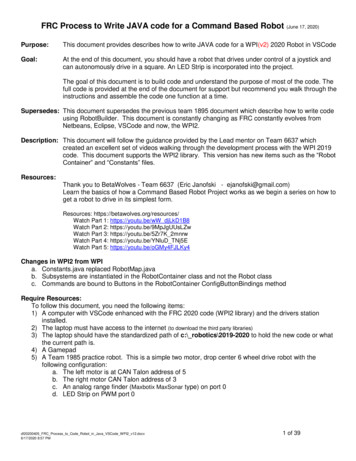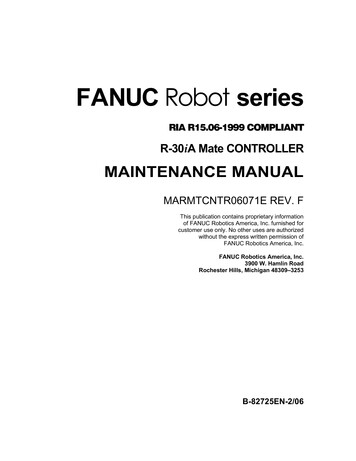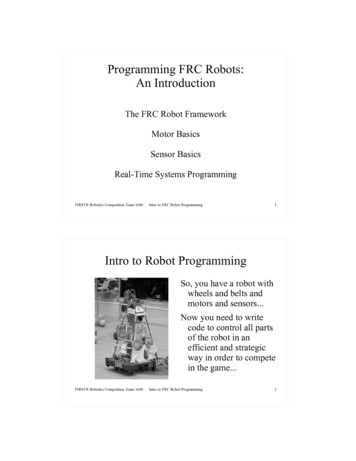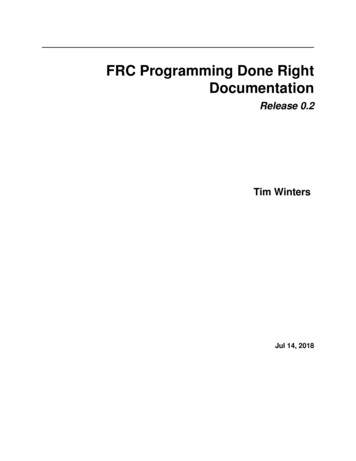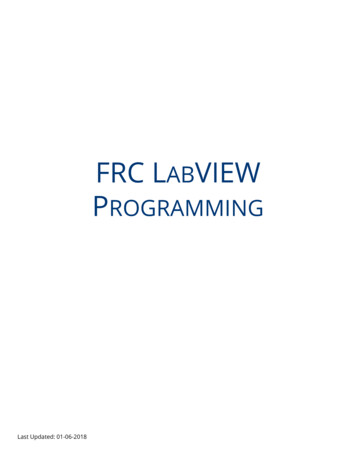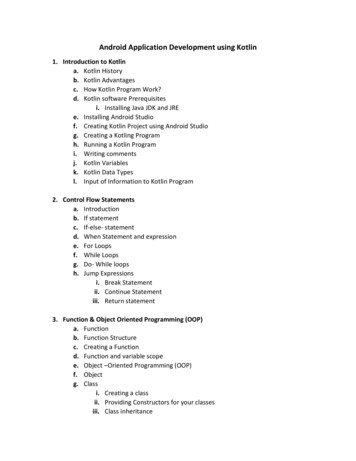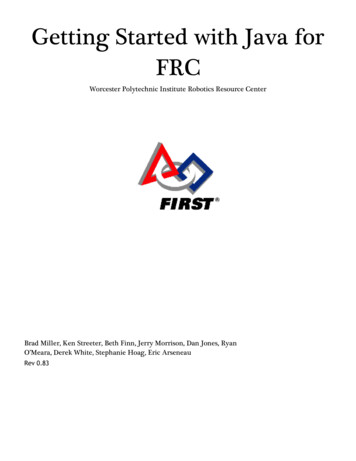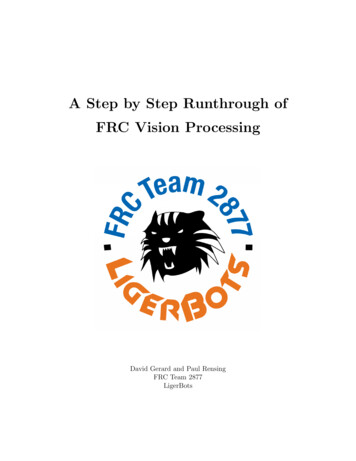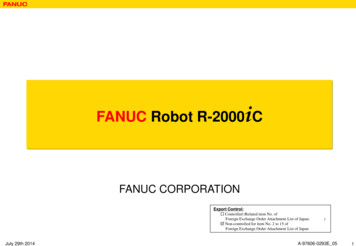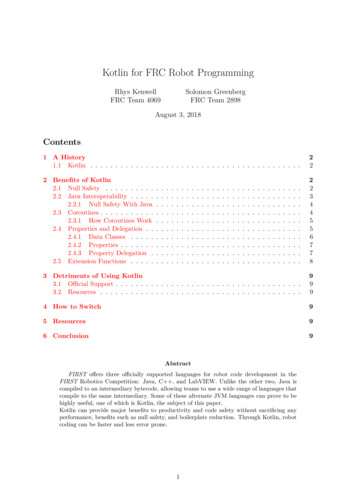
Transcription
Kotlin for FRC Robot ProgrammingRhys KenwellFRC Team 4069Solomon GreenbergFRC Team 2898August 3, 2018Contents1 A History1.1 Kotlin . . . . . . . . . . . . . . . . . . . . . . . . . . . . . . . . . . . . . . . . . .222 Benefits of Kotlin2.1 Null Safety . . . . . . . . . .2.2 Java Interoperability . . . . .2.2.1 Null Safety With Java2.3 Coroutines . . . . . . . . . . .2.3.1 How Coroutines Work2.4 Properties and Delegation . .2.4.1 Data Classes . . . . .2.4.2 Properties . . . . . . .2.4.3 Property Delegation .2.5 Extension Functions . . . . .223445567783 Detriments of Using Kotlin3.1 Official Support . . . . . . . . . . . . . . . . . . . . . . . . . . . . . . . . . . . . .3.2 Resources . . . . . . . . . . . . . . . . . . . . . . . . . . . . . . . . . . . . . . . .9994 How to Switch95 Resources96 Conclusion9.AbstractFIRST offers three officially supported languages for robot code development in theFIRST Robotics Competition: Java, C , and LabVIEW. Unlike the other two, Java iscompiled to an intermediary bytecode, allowing teams to use a wide range of languages thatcompile to the same intermediary. Some of these alternate JVM languages can prove to behighly useful, one of which is Kotlin, the subject of this paper.Kotlin can provide major benefits to productivity and code safety without sacrificing anyperformance, benefits such as null safety, and boilerplate reduction. Through Kotlin, robotcoding can be faster and less error prone.1
1A HistoryC and Java are both relatively older languages, having first appeared in 1985 and 1995respectively. Over their lifespan, these languages have established themselves in many fields. Forinstance, Java is core to Android, and is used frequently for the creation of backend systems.C is used frequently in low level programming, such as in device drivers and operatingsystems. Due to their age, these languages have amassed problems that can make them moredifficult to program in. Java’s rampant getters and setters, and C ’s inconsistent operatoroverloading are two signs that these languages’ age are starting to become a productivity riskto the developer1.1KotlinKotlin is a language that first appeared in 2011. Created from the ground up by Jetbrains,Kotlin was designed to fix problems in Java caused by its age. Since its inception, Kotlin hasexpanded to be able to compile to JavaScript, and native machine code.The design goals were simple Be Java-compatible Compile at least as fast as Java Be safer than Java Be more concise than Java Be expressive[1]2Benefits of KotlinIn using Kotlin, teams will be able to make use of the numerous benefits that it provides.Some benefits are outlined below12.1Null SafetyOne of the most common exceptions in Java code is the NullPointerException. An integralpart of Kotlin’s design is its intrinsic null safety, preventing NPEs at compile-time, protectinga robot from being potentially immobilized on the fieldKotlin’s type system holds an intrinsic distinction for null types. Objects which can potentially be null — so-called “nullables” or “optionals” — are marked with a ?. Kotlin providesmethods of handling nullalble values without aborting program execution if they are null.[2] Safe-call operator1Not all of the benefits of Kotlin are outlined here. See Section 5 — Resources2
The Kotlin safe call operator (?.) allows for safe access of a nullable, returning anothernullable and avoiding situations where attempted access might lead to a crash12 fun main ( args : Array String ) {3var s: String " Hello " // s can never be null4s null // Compile time error56val i: Int null // Compile time error78val j: List String ? null // Ok , marked as nullable9val s: String ? j ?. get (0) // Safe access on j10 }Listing 1: Usage of the safe call operator Elvis operatorKotlin also provides an operator similar to the ternary operator in Java, but tailored tonull types. The elvis operator (?:) takes a nullable on the left, and does one of two things1. If the item is non-null, it returns the inner value of the optional2. If the item is null, it runs the code on the right (This code may be used to providea default value, or to bail out of a method call early).12 fun main ( args : Array String ) {3val i: Int ? 44println ( takesANullable (i)) // Will print 55val j: Int ? null6println ( takesANullable (j)) // Will print -178val s j ?: 5 // Will contain 59 }1011 fun takesANullable (i: Int ?) : Int {12val iUnwrapped i ?: return -1 // If i is not null , the inner value will bebound in iUnwrapped . If it ’s null the function will return -11314return iUnwrapped 115 }Listing 2: Usage of the Elvis operatorIn Java, large amounts of code are devoted to ensuring null safety, code which can easily beavoided or shortened in Kotlin.2.2Java InteroperabilityOne of the key goals of Kotlin was to provide seamless Java compatibility. Kotlin and Javashould be able to exist in the same codebase, and able to interact with each other with aslittle overhead as possible. Any existing Java code or libraries will function when being calledthrough Kotlin and vice versaa, allowing robot code written in Kotlin to interact correctly withnot just WPILib and Phoenix, but any existing Java library you may be using in your robot.[3]3
2.2.1Null Safety With JavaDepending on the code, Kotlin may not be able to provide null safety guarantees when interoperating with Java. However, Java code with nullability annotation (e.g. JSR-305, Eclipse,SpotBugs) will show the correct type in 7282930313233import javax . annotation . Nonnull ;import javax . annotation . Nullable ;public class NullAnnotations {/* ** Returns the literal String " Hello , World !"* Return type in Kotlin is ‘ String ‘ ( Marked with JSR -305 annotation ).*/@Nonnullpublic String nonnullString () {return " Hello , World !";}/* ** Returns null* Return type in Kotlin is ‘ String ?‘*/@Nullablepublic String nullableString () {return null ;}/* ** Returns the literal String " Hello "* Return type in Kotlin is ‘ String !‘ ( May or may not be nullable )*/public String platformType () {return " Hello ";}}When the Kotlin compiler is unable to infer the nullability of a type given nullability annotations, the type will be marked as a platform type2 . Platform types notify the programmerthat a given type may be null, however null safety will not be strictly enforced, leading to theone and only scenario in which Kotlin may encounter an unexpected NullPointerException.2.3CoroutinesKotlin 1.1 introduced a new method of creating non-blocking code: coroutines.[4] Kotlin’scoroutines allows users to write code in an imperative, synchronous-looking fashion, whilesimultaneously leveraging asynchronous processing, and non-blocking IO.2Platform types are denoted as T!4
1 import kotlinx . coroutines . experimental .*23 fun main ( args : Array String ) {4launch {5// suspend while asynchronously reading6val bytesRead inChannel . aRead ( buf )7// we only get to this line when reading completes8.9.10process ( buf , bytesRead )11// suspend while asynchronously writing12outChannel . aWrite ( buf )13// we only get to this line when writing completes14.15.16outFile . close ()17}18 }Listing 3: Example of Kotlin CoroutinesKotlin coroutines are designed to be much more lightweight than threads, while providingmany of the same benefits.2.3.1How Coroutines WorkKotlin coroutines provide functionality for dealing with computations whose result may notbe immediately available. If the value of a computation in a coroutine is not ready, the coroutinecan concurrently “wait” for the operation to complete, without blocking the thread.In practice, coroutines may be applied anywhere that threads are used in a codebase. Theadded functionality for managing asynchronous computations can make asynchronous andconcurrent code dramatically easier to understand and to maintain.2.4Properties and DelegationA very common pattern in both Java and C code bases is that of encapsulating fieldsusing getters and setters. While encapsulation in general is good, the way that it is handled inboth of these languages leads to unnecessarily verbose boilerplate.5
1 /* *2 * A class encapsulating two fields , with implementations of toString () , hashCode (), and equals ()3 */4 public class JavaPojo {5private final String name ;6private int age ;78public JavaPojo ( String name , int age ) {9this . name name ;10this . age age ;11}1213public String getName () {14return this . name ;15}1617public int getAge () {18return this . age ;19}2021public void setAge ( int age ) {22this . age age ;23}2425@Override26public String toString () {27return " JavaPojo ( name " this . name " , age " this . age ")";28}2930@Override31public int hashCode () {32return 31 * this . age this . name . hashCode () ;33}3435@Override36public boolean equals ( Object other ) {37if ( this other ) {38return true ;39}40if ( other instanceof JavaPojo ) {41JavaPojo obj ( JavaPojo ) other ;42return obj . name . equals ( this . name ) && obj . age this . age ;43} else {44return false ;45}46}47 }Listing 4: A Plain Old Java Object (POJO) with encapsulation2.4.1Data ClassesKotlin provides a method of implementing not only getters and setters, but also implementations of toString(), hashCode(), and equals() on classes. These classes, denoted by the datamodifier, act identically to equivalent POJOs, but at a fraction of the code.6
12 /* *3 * A Kotlin data class encapsulating two fields4 * [ name ] is an immutable property of type String ( Cannot be reassigned )5 * [ age ] is a mutable property of type Int ( Can be reassigned )6 */7 data class Person ( val name : String , var age : Int )Listing 5: A Kotlin data class2.4.2PropertiesIn the example of the data class, there are no explicitly defined getters or setters for either oneof the member fields the class encapsulates. Kotlin utilizes a special syntax known as propertyreference syntax to represent getters and setters.123456789101112131415161718192021/* ** Wrapper class around a Talon SRX*/class CustomSRX ( id : Int ) : TalonSRX ( id ) {/* ** Property around a velocity control loop on a talon*/var speed : Doubleget () this . getSelectedSensorVelocity (0)set ( value ) {this . set ( ControlMode . Velocity , value )}}fun main ( args : Array String ) {val customSRX CustomSRX (1)customSRX . speed 150 // Sets the closed loop set point to 150 sensor units /100 ms.val velocity customSRX . speed // Calls the custom getter ( Gets the velocity fromthe sensor )22 }Listing 6: Properties in ActionThough it looks as though there is no encapsulation of the accesses, Kotlin implicitly callsencapsulating functions for each property.32.4.3Property DelegationKotlin also provides a method of abstracting common initialization patterns behind PropertyDelegates. Delegates classes that contain abstracted logic for getting and setting the value of aproperty, denoted by the by keyword.3A Kotlin data class being utilized in Java uses idiomatic getters and setters7
12 fun main ( args : Array String ) {3// [ str ] is abstracted behind the Lazy delegate .4val str by lazy {5// This code will be run the first time the property is accessed ,afterwards the returned value will be given immediately6Thread . sleep (5000) // Simulate expensive computation7" Hello , World !"8}910println ( str ) // This operation will be slowed by 5 seconds as the value iscomputed for the first time11println ( str ) // This operation will be immediate . The value returned the firsttime is given again12 }Listing 7: The Kotlin Lazy delegate2.5Extension FunctionsIn many Java projects, the need to provide custom functionality manifests itself by way ofutility classes. Such classes typically contain functions that take the type they wish to operateon as the first parameter, and any other required operands as extra parameters.12 public class StringUtils {3/* *4* Capitalizes the first letter of a String5* Usage : StringUtils . capitalize (" hello ")6*/7public static String capitalize ( String str ) {8if ( str . isEmpty () ) {9return "";10}1112char [] arr str . toCharArray () ;13if ( Character . isLowerCase ( arr [0]) ) {14return str . substring (0 , 1) . toUpperCase () str . substring (1) ;15} else {16return str ;17}18}19 }Listing 8: Example utility classKotlin allows for the use of a special syntax to represent such operations: extension functions.Extension functions allow for custom functionality to be implemented for a class, and they arecalled as though they are a member function of the class.8
1234567891011/* ** Capitalizes the first letter of a String* Usage : " hello ". capitalize ()*/fun String . capitalize () : String {return if ( isNotEmpty () && this [0]. isLowerCase () ) {substring (0 , 1) . toUpperCase () substring (1)} else {this}}Listing 9: Extension functions in Kotlin3Detriments of Using Kotlin3.1Official SupportAs was stated, the only languages that are officially support for use in FRC are Java, C ,and LabVIEW. If official support is needed at competition by CSAs, using Kotlin decreases thelikelihood that they will be able to help.3.2ResourcesAs Kotlin is less commonly used for FRC than other languages, there will be less coderesources written in Kotlin specifically.4How to SwitchIn order to use Kotlin, teams will need to include more information in the build.gradle fileused by GradleRIO. GradleRIO provides an official quickstart for Kotlin located at track2019/examples/kotlin5ResourcesBelow are listed some resources for learning Kotlin Kotlin Koans — Resource to learn the Kotlin html Kotlin Documentation — Contains the documentation for the Kotlin standard libraryhttps://kotlinlang.org/docs/reference/ Kotlin Coroutines guide — Contains a guide to using coroutines tines/blob/master/coroutines-guide.md Comparison to Java — Contains an in depth comparison to on-to-java.html6ConclusionBy making the switch to Kotlin, a team will be able to reduce boilerplate, write more understandable code, and utilize asynchronous and concurrent functionality. Despite not beingofficially supported, Kotlin is a strong choice worth considering for teams willing to make theswitch.9
References[1] Welcome - Kotlin. English. Jetbrains. url: ] Null Safety - Kotlin Programming Language. English. Jetbrains. url: tml.[3] Calling Java code from Kotlin. English. Jetbrains. url: .html.[4]Roman Belov. Kotlin 1.1 Released with JavaScript Support, Coroutines and more. English.Jetbrains. Mar. 2017. url: -1/.10
instance, Java is core to Android, and is used frequently for the creation of backend systems. C is used frequently in low level programming
